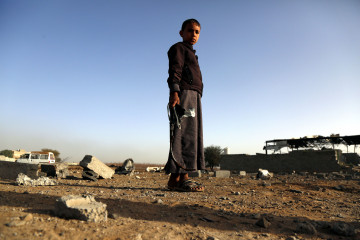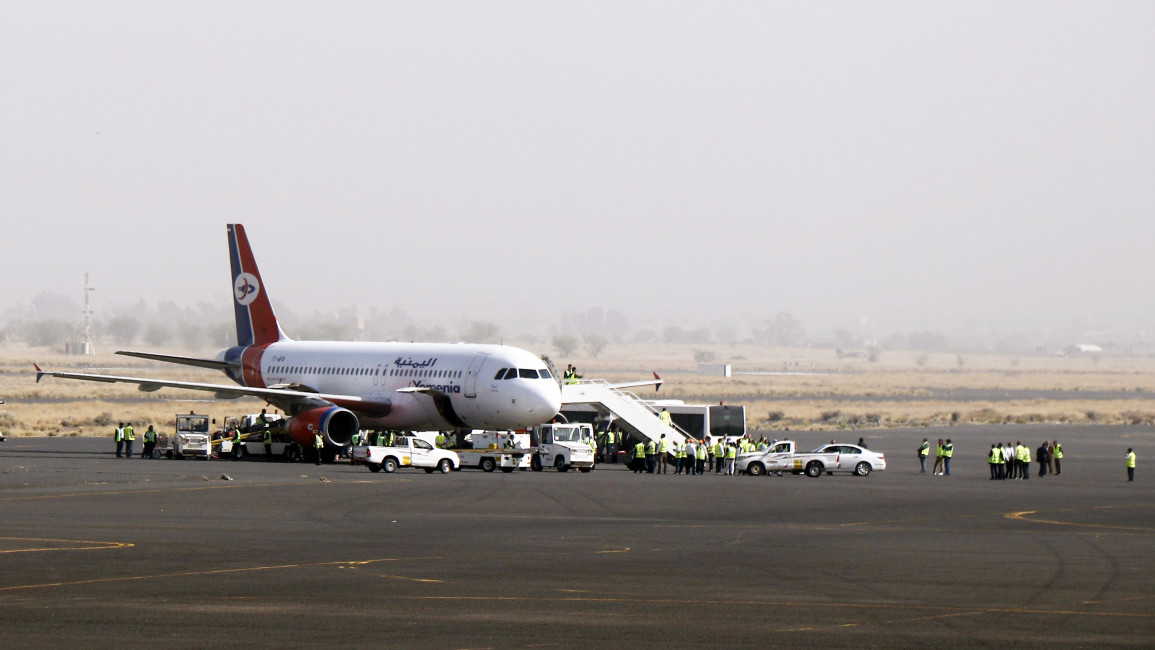

A ray of hope for peace emerged in Yemen this week as the first commercial flight in six years left Sanaa on Monday as part of a truce deal in the country’s civil war.
Carrying 151 passengers, the Yemen Airways flight was headed for the Jordanian capital Amman, according to Houthi media reports.
The eight-year war has damaged nearly all transport infrastructure in the country and the reopening of the airport is an important milestone for millions of Yemenis, particularly in the north.
The resumption of commercial flights is also a success of UN-led peace efforts after years of deadlocked talks.
The sustainability of the initiative, however, is hard to predict given the divisions between Yemen’s rival powers. Indeed, the breakthrough could prove to be short-lived.
Since March 2015, the Saudi-led coalition fighting the Houthis in Yemen has completely controlled Yemen's airspace. The coalition stopped commercial flights to and from Sanaa Airport in 2016.
Ever since then, reopening the airport has been a contentious issue amid seven years of faltering diplomacy and deadly fighting.
"Since March 2015, the Saudi-led coalition fighting the Houthis in Yemen has completely controlled Yemen's airspace. The coalition stopped commercial flights to and from Sanaa Airport in 2016"
The fourth UN Special Envoy to Yemen, Hans Grundberg, with the support of the US special envoy to Yemen, Tim Lenderking, has led extensive efforts to break the political stalemate and stop military escalations.
So far, their efforts have alleviated the humanitarian tragedy.
In March this year, the warring sides in Yemen agreed to a two-month truce that started on 2 April. It has been the longest ceasefire since the war began. The extension of the ongoing armistice is likely, subject to the approval of the warring sides.
Both reopening the airport and permitting fuel ships to reach Houthi-controlled ports are part of the UN-sponsored two-month ceasefire. As a result, the fuel crisis in northern Yemen has been resolved, and the airport is functioning.
This will benefit millions of civilians across the country and is also a source of hope for mediators seeking to end the war.
"Yemen today is witnessing its calmest period since the war began, and these flights are an important step in further improving the lives and opportunities for the Yemeni people," Adrienne Watson, spokesperson of the White House National Security Council, said.
Grundberg, the UN envoy to Yemen, also commented on the successful resumption of flights from Sanaa airport.
"This should be a moment of coming together to do more, to start repairing what the war has broken, and to follow through on all the Truce commitments to build trust and move towards resuming a political process to sustainably end the conflict."
While UN-led efforts have paid off this time, the coming weeks will reveal if this success will pave the way towards a comprehensive political solution and continued military deescalation.
|
|
"This development has partially addressed the humanitarian side. It has facilitated the travel of sick people to get treatment abroad or enabled people who are stranded for years to return home,” a political analyst in Houthi-controlled Sanaa told The New Arab.
“The airport reopening cannot guarantee the opening of roads between the Yemeni provinces or lifting the Houthi siege imposed on Taiz city."
The political gulf between Yemeni rivals is still vast. Therefore, mitigating humanitarian concerns should not necessarily be viewed as genuine rapprochement.
"The war in Yemen is rooted in conflicting ideologies and visions. The Houthi group is interested in a kingdom-like country, and the Yemeni government seeks a democratic and republican country. Thus, concessions for humanitarian ends are not necessarily permanent political concessions," the political analyst added.
"The political gulf between Yemeni rivals is still vast. Therefore, mitigating humanitarian concerns should not necessarily be viewed as genuine rapprochement"
Nonetheless, this latest breakthrough has been heartening for millions of Yemenis, and the credit goes to the UN envoy, many Yemeni civilians say.
When the first flight took off from Sanaa on Monday morning bound for Amman, Yemenis in Sanaa, other provinces, and abroad were overjoyed.
“I was sleeping when I heard the sound of the aircraft. I first thought that it was a UN plane. I looked up outside the window, and I saw the Yemenia plane,” Hassan Mohammed, a resident living near Sanaa Airport, told The New Arab.
“That reminded me of the pre-war time. We missed those peaceful days. What was a daily routine at the airport had become a dream."
Despite his joy, Mohammed is not optimistic that the flights will continue without disruption for a prolonged period as the key political players in Yemen have not reached a final political resolution to the conflict.
"The operation of commercial flights from Sanaa Airport cannot be considered a cure-all, and I expect its shutdown at any time. Even if the airport continues operating, it does not mean the end of the strife. The warring sides fight over the country's presidency, not over the airport."
In a tweet on Monday, Hussein Al-Ezi, a senior Houthi official, warned that any obstruction to the agreed-upon flights would mean the outbreak of war again.
"There will be two daily flights throughout the remaining period of the truce,” he wrote.
“We hope the quick implementation of that [agreement] and the absence of obstruction and hindrance behaviours. [...] Any obstruction or hindrance will see the return of war, and this should not be allowed to happen."
Such rhetoric indicates that the option of more war in Yemen has not been entirely eliminated, and the Sanaa Airport reopening is but a small step in the process of ending the conflict.
Unfortunately in Yemen, any progress in peace talks is shaky, with the possibility of looming violence ever-present.
The writer is a Yemeni journalist, reporting from Yemen, whose identity we are protecting for their security.





 Follow the Middle East's top stories in English at The New Arab on Google News
Follow the Middle East's top stories in English at The New Arab on Google News


